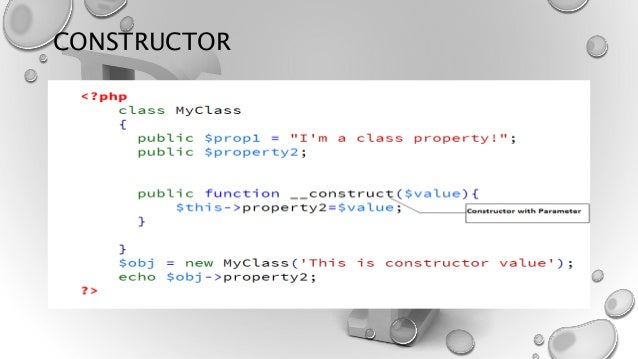
In this Tutorial, we are going to learn about Complete Tutorials of PHP OOP Constructor with Example code. Through this we will learn about the concept about constructor. But first let me give you a brief explanation of what is Object-oriented programming (OOP)?
What is Object-oriented programming (OOP)
Object-oriented programming consists of combining a set of variables (properties) and functions (methods), which are referred to as an object. These things are arranged into classes in which individual items can be combined. OOP can enable you to consider the objects and the many activities in connection with the objects in a program’s code.
for more details you can go on my previous article Read More. [Object-oriented programming (OOP) Concept Simplified!]
What is Constructor Function in PHP?
When we create a class instance object, we normally have to set the attribute values to individual values before we can utilize them effectively. Constructors are unique member methods that are used to build up freshly produced object instances from a class. They are an important aspect of PHP5’s object-oriented approach. When you create an object, you may use a Constructor function to set the properties of the object.
Whenever, you use __construct() function. PHP automatically executed this function When you create an object from a class.
Why do we need a constructor ?

As we know, a constructor is a specific function and it is run automatically when any subject of a class is set up, so that in our class we may profit from the constructor . Before utilizing it we may set the object up or start creating sessions so that we do not have to begin with each class method.
You can’t create class instances without a constructor. Imagine you can build the files class, but you can’t generate any files based on the class without constructors.
Some Advantages of using constructor:-
- The constructor may be used to invoke any class methods by initializing the class variables.
- The constructor may be utilized for repeated use without resetting the item once the item was created.
- If required, the child constructor may call the parent constructor.
- Using a constructor, such as session creation, may simply be done with common tasks need to be performed at one time.
How to create a constructor in PHP?

PHP gives us a particular __construct() function for building an object.
The function __construct() has parameter to insert their values into our chosen attributes.
We may now insert a value between the parenthesis when constructing the class object. The value is subsequently assigned to the assignment.
Example 1- create a constructor with __construct()
In this Example, We want the constructor to produce the first and last name object instantly.
When creating the objects of both people, we feed their names right into the parenthesis, calling the constructor and assigning the names that we type to the attributes.
It enables us to save each attribute from the stage of doing this manually.
Example 2- manual construction
Output:-
The output may be the same, but we can input a lot less code from the function.
What are the Types of Constructor in PHP?
In any object-oriented programming, three types of Constructor are mainly utilized. The following are listed:
- Default Constructor: It doesn’t have any arguments, but the default Constructor values can be dynamically passed on.
- Parameterized Constructor: The parameters are taken and the data members might be given varied values.
- Parameter-less Constructor: It functions as the default Constructor. It is also known as a Constructor defined by users.
What is Default Constructor?
This Constructor has no parameter and the name __construct() is declared. The standard values of the class members may be assigned and other class methods may be called dynamically using the default builder.
Example – The code below explains how the standard Constructor is used in PHP. Here the User Class has three class variables and the default Constructor function which, when creating an object, initializes the class variables with default values. The class variables values will eventually be reported using the class object.
Output:- After running the code, the following output appears. The class object, $objuser, is declared using the default Constructor function __construct() and the class variables with default values are populated automatically.

What is Parameter-less Constructor?
If the class name of any method in the class is defined and no argument is included, that method is called the Parameter-less Constructor. It functions as the default Constructor. It is also known as a Constructor defined by users.
Example – The code below demonstrates how the user-defined constructor parameter is used with a PHP code. In this case, the constructor function with the class name is proclaimed to initialize the class variables with standard values, and the display() method is declared to report the class variables’ values.
Output:- After running the code, the next output is seen. The parameter-less built-in process User() is called automatically when the object in the class, $objuser has been defined, and class variables are populated with default values.

What is Parameterized Constructor?
The user-defined constructor that contains an argument is called a parameterized constructor. The parameter values of this builder are supplied when the object is being created and this constructor can also call the other methods of the class.
Example- A user-determined builder with a PHP code is shown in the following code. The function called User() comprises three parameters here which are used to store and initialize class variables with the provided values at the time of object creation. The display() method is used to output the variables of class.
Output:- After running the script, the next output is seen. Here, by utilizing a class object, the display() function is called.

Conclusion:
In this Tutorial you have seen the clear concept of The usage of different types of constructors in object-oriented PHP has been presented in this tutorial by using simple examples to assist the readers know the properties of the function and use it effectively in their script. Thank you for being our learning partner.
- Building a DevOps Culture: Tips and Strategies - April 4, 2024
- Why Understanding DevOps Could Be Your Key To Success In The Music Industry - April 4, 2024
- Top Picks: The Best Laptops for Graphic Designers in 2024 - March 31, 2024

